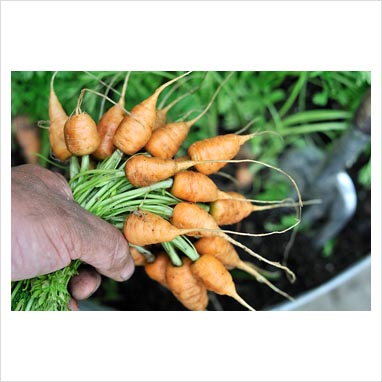Choosing the Right Plants
Today is day 8 of my Urban Garden Project. The herbs I started are popping out of the soil more each day. I'm still waiting on my Parsley to sprout but that doesn't surprise me as it is known for being slow to start. My basil has begun to stretch taller and looks like it already wants to add more leaves. The chive sprouts are more than just a green spec at soil level now and have since split into thin segments that remind me of grass. I've been watering things every other day so that the roots won't get too wet and rot. Damping off, as it's called, is a common reason indoor plants die.
As my garden progresses I find myself thinking more about what else I will plant. What do I want to cook with in 2-3 months? I must take into consideration things like root space, sun and temperature requirements, production time, and any other specific needs a type of vegetable would need. For this info I look to Google. (The chart at the very bottom of this page is useful.)
From reading materials and knowing what I like to cook with I have compiled a list that I will keep in mind when I go to acquire seeds. This list has already been narrowed down to what I think will work with partial sun, small space, and won't be hard to maintain.
 |
| Picture used from here |
~ Onions
~ Carrots
~ Cherry Tomatoes
~ Spinach
~ Herbs
~ Lettuce/Kale
Each of these plants I will research individually at this point to see what to look for when buying seeds. On my tiny budget it's very important that I choose plants that will give me the best chance to succeed. I am particularly excited to try my hand at strawberries. They are one of my favorites and I've never grown them before. From my readings I've determined that an Everbearing variety would be my first pick since they tend to do the best in containers. One of the biggest challenges of growing strawberries is birds. They love to pick them before humans get the chance. Growing them indoors will prevent this and hopefully greatly increase the amount I get to eat!
Spinach and Lettuce are quick producers that I can continually harvest as needed for several weeks until the plant tires out. After a few weeks of continual production the nutritional content of these will start to decline as well as the taste. These are crops I will need to continually plant every 3-4 weeks to have new ones ready to go.
Carrots are said to do well in containers and with partial sun so I plan to have these closer to the ground in my grow room. The windows are high in the room so any plants that need more light will be hung higher. Anything I plan to harvest regularly I will also keep within arms reach to make it easier on me and encourage the maximum usage of my fresh produce.
The actual varieties I will use will depend on what is available at the store as well as what the packet says the variety needs. Some types will do better in containers than others such as the small tomatoes will commonly do better than the beefy varieties that are known for producing large fruits. I believe that the basic types of plants I have chosen to start with will encourage success and help me get into the routine of constantly sowing seeds. Once I feel comfortable with the amount I am growing I will be able to decide what else I would like to add without fear of overburdening myself. I want to avoid waste if at all possible which I can help to prevent by starting off slow despite the fact that I am extremely excited to have fresh from home produce.
I also decide today that should I need a quick and easy addition to a salad fresh sprouts would be a great option. There are many different types and they all produce quickly for consumption. Sprouts also have very high nutritional value for such a small package. I am still looking at ways to grow potatoes in a small area. I haven't found anything yet but I am confident I will.
 |
| Kale is in the cabbage family and works great for cooking! |

No comments:
Post a Comment